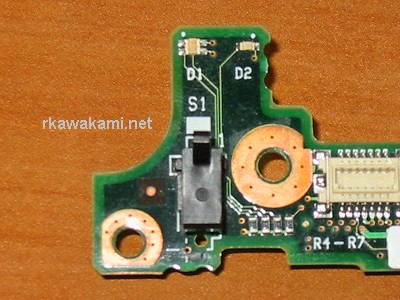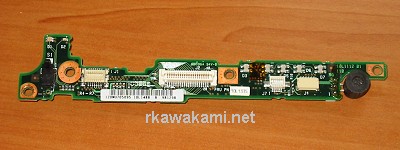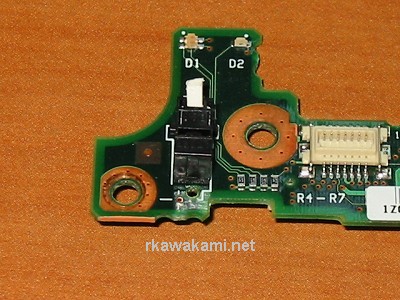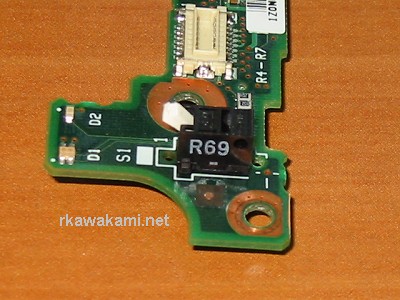 The lid closure switch as viewed from the top of the board (and how it sits when installed in the laptop). The small black
lever is the only part of the switch that is visible from the outside of the laptop.
The lid closure switch as viewed from the top of the board (and how it sits when installed in the laptop). The small black
lever is the only part of the switch that is visible from the outside of the laptop.
 As used in the IBM 600 Thinkpad series, the Sub Card is a small printed circuit board which sits on top of the motherboard
and provides connections to the keyboard and LCD panel. It also contains the lid closure switch and the microphone. The IBM
FRU (field replaceable unit) numbers associated with the
version of the board for a 600X laptop are 10L1335 and 10L1488. I own several 600X laptops and have upgraded and repaired
them over the years. This page was created in order to document some information about this particular card, describe a
repair that I have made to the board and to offer it as a case study on how I identify and locate sources of replacement
components. If you want to try working on your own 600X, I would highly suggest that you first download the IBM
Hardware Maintenance Manual, a 932KB
Adobe Acrobat PDF file.
As used in the IBM 600 Thinkpad series, the Sub Card is a small printed circuit board which sits on top of the motherboard
and provides connections to the keyboard and LCD panel. It also contains the lid closure switch and the microphone. The IBM
FRU (field replaceable unit) numbers associated with the
version of the board for a 600X laptop are 10L1335 and 10L1488. I own several 600X laptops and have upgraded and repaired
them over the years. This page was created in order to document some information about this particular card, describe a
repair that I have made to the board and to offer it as a case study on how I identify and locate sources of replacement
components. If you want to try working on your own 600X, I would highly suggest that you first download the IBM
Hardware Maintenance Manual, a 932KB
Adobe Acrobat PDF file.
 The lid closure switch as viewed from the top of the board (and how it sits when installed in the laptop). The small black
lever is the only part of the switch that is visible from the outside of the laptop.
The lid closure switch as viewed from the top of the board (and how it sits when installed in the laptop). The small black
lever is the only part of the switch that is visible from the outside of the laptop.
 Switch as viewed from the side. You can't see it from this picture, but there are some letters on this side of the switch
which gave me a clue on what to search for when finding a replacement. No, it wasn't a part number or manufacturer's name!
Switch as viewed from the side. You can't see it from this picture, but there are some letters on this side of the switch
which gave me a clue on what to search for when finding a replacement. No, it wasn't a part number or manufacturer's name!
The 600X laptop that my older daughter has been using for some time now has a broken lid closure switch. Because of the way the switch broke (always stuck "on") and since my daughter uses the screen saver function in Windows to turn off the display and never uses the sleep or hibernation modes, it didn't bother her (or me) to not fix the switch. Recently while lurking at the Thinkpads.com forum for 600 series laptops, a user there inquired about the possibility of replacing a broken lid switch. In answering his question, I decided to try to search for a replacement switch, ignoring the obvious (and most likely, cheapest) solution which was to replace the entire Sub Card.
spdt lever switch pcb mount
The first hit was for a list at Digikey.com for basic switch types made by Cherry. I followed a couple of the links for lever switches but didn't see anything close to the one on the Sub Card. The second hit was for a subminiature switch made by Omron. I nearly fell over! The only difference that I could see was that the Omron lever was white and a little bit longer than the one I had in my hand. There was a link to a datasheet that could be downloaded so I clicked on it and got all of the physical dimensions. Out came the calipers and I checked the width, length, height, lead spacing, position and sequencing of the NC, C and NO terminals, etc. and everything seemed to match, except for the longer lever. Figuring that it was made of plastic and that a file or Dremel™ would make quick work to shorten it, I decided that this is what I was going to order. However there were four different part numbers listed on the datasheet. There was a shorting and a non-shorting version, as well as two different operating force options. The shorting options refer to the way that the switch contacts operate when moving the lever between the "up" to the "down" positions. For the shorting version, there is a brief point during the movement of the lever where all three terminals are electrically connected together (i.e. shorted to each other). For the non-shorting version, this does not happen. To check the existing switch I connected an ohmmeter to the NC and NO terminals and operated the lever up and down and listened to the meter for any beep which would indicate a short. There wasn't any so the original switch was of the non-shorting type. That left the operating force option to be determined. This is the amount of pressure pushing down on the lever in order for it to switch from the "up" to the "down" position. The datasheet said that the "general purpose" version requires 130 grams (the D3C-xx10 part numbers) and the "low operating force" version needs only 40 grams (D3C-xx20 part numbers). So how do you determine the pressure required? Easy, as long as you have a small digital scale. A postage or kitchen scale works best as it generally has the accuracy and resolution needed to measure down to a few grams. Turning the scale on and placing the switch lever on top of the scale and slowly pushing down, I watched the readout to see what the weight (force) was when the lever started moving. Repeating this a couple of times and averaging out the results said that the original switch required somewhere around 35-38 grams of force. So that means that the Omron D3C-1220 switch is what I needed. Believe it or not, the hardest part is not figuring out what you need to order, it's where you can order it from in single-unit quantities. Again, luck was on my side in this search because on the Omron page are links where you can check for distributor inventory. Clicking the link for the D3C-1220 switch gave me a list of distributors that stocked this switch. Both Digikey and Mouser were listed as having them in stock. I selected Mouser since I have dealt with them several times in the past and because I knew that most of their items can be ordered singlely. A few days later the switch arrived and I removed the original switch from a spare Sub Card I had on hand and compared it to the Omron version.
 The Omron D3C-1220 switch is on the left (with the white lever) and the original switch is on the right. You can see that
the Omron switch has a much longer and slightly thicker lever. About 2mm of the lever needs to be cut off to match the
length of the original switch. Thats's roughly where the hole in the lever begins.
The Omron D3C-1220 switch is on the left (with the white lever) and the original switch is on the right. You can see that
the Omron switch has a much longer and slightly thicker lever. About 2mm of the lever needs to be cut off to match the
length of the original switch. Thats's roughly where the hole in the lever begins.
 Here's what the Omron switch looks like after a small bit of surgery with my Dremel. I then soldered the Omron switch
onto the Sub Card and installed it in one of my 600X laptops.
Here's what the Omron switch looks like after a small bit of surgery with my Dremel. I then soldered the Omron switch
onto the Sub Card and installed it in one of my 600X laptops.
 A repeat of the previous two pictures of the Sub Card, but now showing the Omron switch.
A repeat of the previous two pictures of the Sub Card, but now showing the Omron switch.

 The new switch is quite evident when the 600X is re-assembled since it has the white lever. I installed this card into
my external antenna project laptop. The original Sub Card
will now go into my daughter's laptop when she comes home for summer vacation.
The new switch is quite evident when the 600X is re-assembled since it has the white lever. I installed this card into
my external antenna project laptop. The original Sub Card
will now go into my daughter's laptop when she comes home for summer vacation.
 This is the position of the lid where it triggers the switch and turns off the display. I'm pretty sure it's close to where
the original switch also turned off. If you are going to try this replacement, be careful that you don't cut the lever too
short otherwise the switch may not be triggered when the lid is closed. The lever on my switch is actually a little bit
shorter than the original one but it seems to be working fine.
This is the position of the lid where it triggers the switch and turns off the display. I'm pretty sure it's close to where
the original switch also turned off. If you are going to try this replacement, be careful that you don't cut the lever too
short otherwise the switch may not be triggered when the lid is closed. The lever on my switch is actually a little bit
shorter than the original one but it seems to be working fine.
Omron D3C-1220 Hinge Lever Non-shorting Low Operating Force switch: $1.08US
Shipping charge for USPS Priority Mail, plus handling charge: 6.25
Sales tax: 0.09
Total: 7.42
I actually ordered two switches just in case I screwed up modifying the lever, but that's the cost for one. At the moment,
eBay has 22 listings for IBM Sub Cards, if searching for "10L1335 or 10L1488". They run from $5 for ones up for bidding, to
$30 for a Buy It Now. All these prices include shipping; I can only assume that's for addresses in the U.S. International
would of course be more. Checking on recent purchases, those range from $11 to $22. So, as of this particular point in
time for eBay traffic, yes, it was cheaper to buy the switch versus a complete Sub Card.